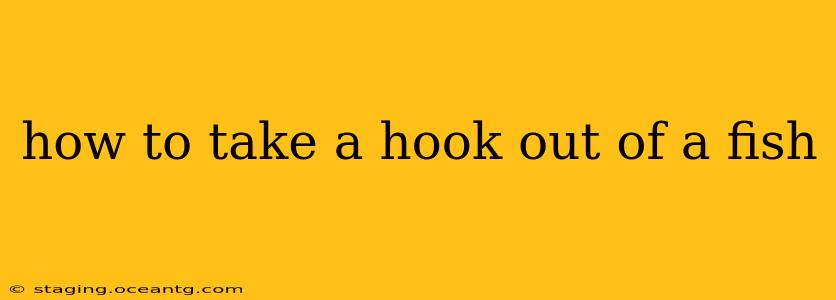How to Take a Hook Out of a Fish: A Comprehensive Guide
Successfully removing a hook from a fish is crucial for both the fish's well-being and the ethical practice of fishing. A poorly executed removal can cause unnecessary injury or even death. This guide will walk you through the process, covering various scenarios and providing tips for a safe and effective hook extraction.
What Tools Do I Need to Remove a Hook From a Fish?
The best tools for hook removal depend on the hook's location and size, but having a few options on hand is always a good idea. These include:
- Long-nose pliers: These are essential for reaching hooks deep in the fish's mouth or throat. Look for pliers with a comfortable grip and good leverage.
- Hook remover: These specialized tools can make hook removal much easier, especially for smaller hooks or those deeply embedded. They often have a small, curved hook that helps to dislodge the barb.
- Gloves: Protect your hands from sharp hooks and potential fish slime.
- Wet towel or cloth: This helps to keep the fish moist and control its movement.
How to Remove a Hook from a Fish's Mouth?
This is the most common scenario. Follow these steps:
- Get a Grip: Securely hold the fish, keeping it wet and supporting its weight. Use a wet towel if necessary.
- Access the Hook: Use the long-nose pliers or hook remover to carefully grasp the hook.
- Remove the Hook: Gently pull the hook outward, following the path it entered. If the barb is facing outward, you may be able to back it out. If it's deeply embedded, you might need to slightly twist the hook to loosen it.
- Check for Damage: Once the hook is removed, check the fish's mouth for any signs of injury. If there's significant damage, consider releasing the fish immediately.
What if the Hook is Swallowed by the Fish?
This is a more serious situation, requiring careful handling and potentially more advanced techniques. It is important to:
- Assess the Situation: Determine the hook's depth and location. If it's far down the throat or lodged firmly, it's best to seek assistance from an experienced angler or wildlife rehabilitator. Attempting to remove a deeply embedded hook can cause irreparable damage.
- Consider Cutting the Line: In some cases, cutting the line close to the hook might be the best option, allowing the fish to pass the hook naturally. This method is often used for deeply swallowed hooks or hooks in the stomach. Always consider the potential long-term effects on the fish's health and overall survival.
- Release the Fish: Even if the hook isn't completely removed, releasing the fish is crucial to allow it to recover.
How to Handle Different Hook Types?
The removal process may differ slightly depending on the hook type:
- Barbless hooks: These are easier to remove as they don't have a barb to catch on tissue. You can often simply back them out.
- Barbed hooks: These require more careful handling. You may need to use pliers to compress the barb and allow the hook to slide free. In some cases, it might be easier to cut the barb off with wire cutters.
What if I Can’t Remove the Hook?
If you're struggling to remove the hook, it's best to:
- Seek Assistance: Consult with experienced anglers or wildlife rehabilitators.
- Prioritize the Fish's Welfare: The fish's health should always be the top priority. If the hook cannot be safely removed, it is often best to release the fish rather than cause further damage.
Remember: Always handle fish with care and respect. The goal is to minimize stress and injury during the hook removal process. If you are unsure about the correct procedure, it's always advisable to err on the side of caution and seek professional help.
